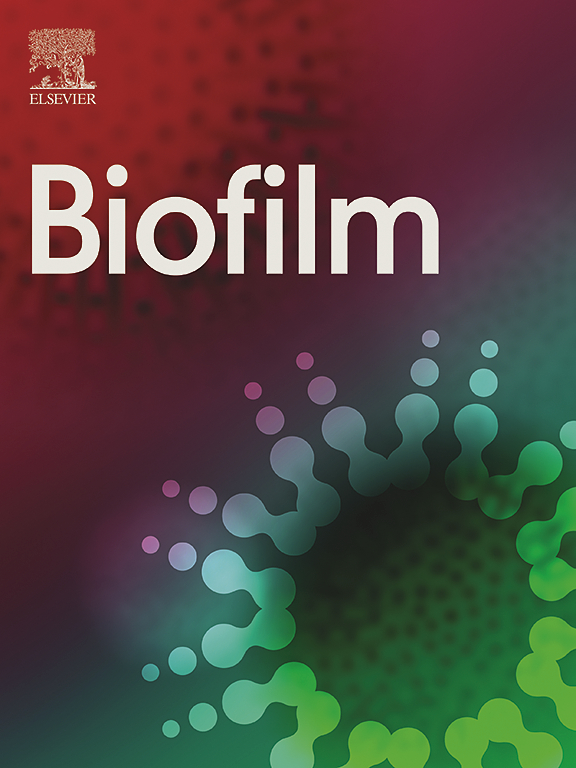Identification and comparison of protein composition of biofilms in response to EGCG from Enterococcus faecalis and Staphylococcus lugdunensis, which showed opposite patterns in biofilm-forming abilities
IF 4.9
Q1 MICROBIOLOGY
引用次数: 0
Abstract
Bacterial biofilm is resistant to conventional antibiotic treatments, leading to complications associated with many infection-related human diseases. Epigallocatechin Gallate (EGCG), a phenolic catechin enriched in green tea, is recognized for its anti-bacterial and anti-biofilm activities. In this study, we examined the protein components of the biofilms formed in the absence or presence of EGCG using Enterococcus faecalis and Staphylococcus lugdunensis, which had shown opposing patterns in biofilm formation. A clustering heatmap revealed that the two microorganisms expressed the different protein sets in response to EGCG. Proteins that were noticeably upregulated included those associated with stress responsiveness and gluconeogenesis in E. faecalis, and gene modification in S. lugdunensis. Conversely, downregulated proteins were related to tRNA-modifying enzyme activity in E. faecalis, and anabolic metabolism in S. lugdunensis. Among the proteins identified only in EGCG-responsive biofilms, enzymes involved in de novo purine biosynthesis were enriched in E. faecalis, while proteins likely to cause DNA instability and pathogenicity changes were abundantly present in S. lugdunensis. The classification based on gene ontology (GO) terms by microorganism exhibited that metabolic process or catabolic activity was at the top rank in E. faecalis with more than 33 proteins, and in S. lugdunensis, localization or transport was highly ranked with 4 proteins. These results support the hypothesis that EGCG might cause different cellular programs in each microorganism. Finally, comparison of the proteomes between two groups that form biofilms to similar extents discovered that 2 proteins were commonly found in the weak biofilm-forming groups (E. faecalis and EGCG-responding S. lugudunensis), whereas 9 proteins were common among the strong biofilm-forming groups (S. lugdunensis and EGCG-responding E. faecalis). It was suggested that these proteins could serve as potential indicators to detect the presence and predict the extent of biofilm formation by multiple microorganisms. Taken all together, proteomics data and analyses performed in this study provided useful and new information on the proteins embedded in the biofilms formed at the specific conditions, which can aid in diagnosis and the development of tailored treatment strategies.
鉴定和比较粪肠球菌和卢格杜恩葡萄球菌生物膜对 EGCG 反应的蛋白质组成,这两种球菌的生物膜形成能力表现出相反的模式
细菌生物膜对传统抗生素治疗具有抗药性,导致许多与感染相关的人类疾病的并发症。表没食子儿茶素没食子酸酯(EGCG)是绿茶中富含的一种酚类儿茶素,其抗菌和抗生物膜活性已得到公认。在这项研究中,我们利用粪肠球菌和卢格杜恩葡萄球菌研究了在没有或有 EGCG 的情况下形成的生物膜的蛋白质成分,这两种球菌在生物膜形成过程中表现出截然相反的模式。聚类热图显示,这两种微生物对 EGCG 的反应表达了不同的蛋白质集。明显上调的蛋白质包括与粪肠球菌的应激反应能力和葡萄糖生成有关的蛋白质,以及与卢格杜氏菌的基因修饰有关的蛋白质。相反,下调的蛋白质在粪肠球菌中与 tRNA 修饰酶活性有关,在卢格杜氏菌中与合成代谢有关。在仅在 EGCG 反应型生物膜中发现的蛋白质中,参与嘌呤生物合成的酶在粪肠球菌中富集,而可能导致 DNA 不稳定和致病性变化的蛋白质则大量存在于 S. lugdunensis 中。根据基因本体论(GO)术语对微生物进行的分类显示,粪肠球菌的代谢过程或分解活动排在首位,有 33 个以上的蛋白质;而在卢格登氏菌中,定位或运输排在很高的位置,有 4 个蛋白质。这些结果支持了一种假设,即 EGCG 可能会在每种微生物中引起不同的细胞程序。最后,比较了形成生物膜程度相似的两组微生物的蛋白质组,发现形成生物膜程度弱的微生物组(E. faecalis 和 EGCG 对应的 S. lugudunensis)中常见 2 种蛋白质,而形成生物膜程度强的微生物组(S. lugdunensis 和 EGCG 对应的 E. faecalis)中常见 9 种蛋白质。研究表明,这些蛋白质可作为潜在的指标,用于检测多种微生物是否形成生物膜以及预测形成生物膜的程度。总之,本研究中的蛋白质组学数据和分析为特定条件下形成的生物膜中的蛋白质提供了有用的新信息,有助于诊断和制定有针对性的治疗策略。
本文章由计算机程序翻译,如有差异,请以英文原文为准。
求助全文
约1分钟内获得全文
求助全文

 求助内容:
求助内容: 应助结果提醒方式:
应助结果提醒方式:


